
* The A-10 owed its birth to two influences: the inadequacies of close air support aircraft used in Vietnam, and the need to counter Soviet armored might in Europe. The development program that emerged from these roots was a model of clean organization and management, and it produced an unusual and very neatly engineered product. This chapter describes the origins and specifics of the A-10.
* During the Vietnam War, the US Army and the US Air Force were often at odds over the issue of close air support. The Air Force regarded CAS as their mandate and were opposed to Army attempts to take over that role for themselves, while the Army felt the Air Force wasn't responsive enough to Army needs. The Army was not allowed to operate armed fixed-wing aircraft -- though there was a little cheating on this point -- but the service was able to acquire armed helicopter gunships. The Air Force did obtain quantities of the antiquated but excellent piston-powered Douglas A-1 Skyraider or "Spad" strike aircraft originally developed for the Navy, which earned the appreciation of the ground-pounders by its ability to carry a big warload, dish out and take punishment, and remain on combat station for an extended period of time.
USAF brass had mixed feelings about the Spad, regarding piston combat aircraft as a thing of the past, but the "fast-mover" jets preferred by the service were nowhere near as adequate in the CAS role -- they came in quick, dropped their warloads, and left, since they generally lacked both the endurance and the resistance to damage to let them hang around on the battlefield. They were also much more expensive in every respect than the A-1. The bias against the Spad was not completely unreasonable, however, since the enemy continually improved their anti-aircraft capabilities throughout the war, and the Skyraider suffered accordingly. Something more modern really was needed.
Late in the war, the USAF shifted the CAS mission to the jet-powered Vought A-7 Corsair II or "SLUF (Short Little Ugly 'Fella')". The A-7 had been developed against a US Navy requirement for a carrier-based strike fighter to replace the Douglas A-4 Skyhawk. The SLUF was an excellent aircraft, but it was designed for the strike-interdiction role, not for the battlefield CAS mission. It was not really the equal of the Spad for getting down in the mud with the troops, and turning the tables against the black hats.
Well before that, in mid-1966, the USAF began to put together an "Attack Experimental (AX)" program to develop a CAS aircraft that could do the job far better than the Skyraider. An initial request for proposals (RFP) was issued in March 1967. The AX, as defined in the RFP, was to match the Skyraider in warload and endurance, but was to be substantially faster while being extremely maneuverable, with a tight turning radius to keep in on target, and was to have short take-off and rough field capability. The AX was to be highly survivable through the use of armor and redundant systems, including twin engines, while being cheap to buy, plus easy to operate and maintain from forward bases. One of the more interesting features of the AX was that it was to be armed with a fast-firing cannon, most likely a variant of the General Electric (GE) M61 "Vulcan" 20-millimeter six-barreled Gatling-type gun.
* While the industry worked on proposals, the AX definition shifted slightly. The North Vietnamese began to introduce armor in combat in 1967 and 1968, and during the Six-Day War of 1967 the Israelis had shown that their French-built Mirage IIIC fighters could kill Arab heavy tanks using the aircraft's twin 30-millimeter DEFA automatic cannon, punching through the thin armor on the top.
Even during the Vietnam War, the US Army regarded the service's primary mission as dealing with a Soviet armored offensive into Western Europe. NATO was outnumbered by the numbers of troops and tanks that the Warsaw Pact could field, and into the early 1960s the US Army favored the nuclear option as the best equalizer, fielding thousands of tactical nuclear weapons. Over time, the uneasiness over heavy reliance on the nuclear option as a defense increased. Going nuclear even with very small tactical nuclear weapons was an obvious first step towards a full-blown nuclear exchange that could destroy civilization; even supposing that could be avoided, major use of tactical nuclear weapons would still ruin the countries the US was supposed to be protecting; and in general, relying strictly on the nuclear option gave very little flexibility for dealing with a crisis.
The Army was putting a lot of effort into acquiring nuclear weapons that really couldn't be used without direct authorization from the commander in chief -- the President of the United States -- and no competent field commanders feel comfortable relying on tools they have no assurance can be actually used, or for that matter train to use in any realistic way. In effect, battlefield nuclear weapons were worthless. The inflexibility of the nuclear option meant the US needed to look to more capable conventional weapons as equalizers to Soviet armor. The Air Force began to see the AX less as a counterinsurgency weapon than as an anti-armor weapon, and accordingly adjusted the requirement to feature a more powerful cannon. That was not a minor change, since the cannon was almost certainly going to be very big and the aircraft would have to be effectively designed around it.
* In the meantime, the various manufacturers were wrestling with the RFP, particularly the speed and endurance requirements. The only solution provided by traditional engine technology was the turboprop, since turbojets simply didn't have the fuel economy, but turboprops required heavy-duty reduction gearboxes and variable-pitch propellers that made them more complicated and heavier than turbojets. The use of propellers also imposed restrictions on engine placement. Although turboprops worked fine on cargolifters, the more the designers looked at turboprops for the AX, the more troublesome they seemed.
Douglas had actually tried to develop a turboprop follow-on to the Skyraider named the "A2D-1 Skyshark" in the 1950s, and it had been one of the worst aircraft the firm ever built, plagued with continuous development problems. It never entered production. To be sure, the turboprops available in the early 1950s were notoriously troublesome in themselves, but even the much more mature turboprops available in the late 1960s didn't seem to fit the AX very well.
Fortunately, there was a new option, in the form of the "high-bypass turbofan". The first practical turbofan engines, which were basically turbojets with a fan attached to increase airflow, were introduced in the late 1950s and provided substantially improved fuel economy relative to turbojets. The problem with these early turbofan engines from the point of view of the AX was that they were only efficient at fairly high speeds, and they would not be efficient at the relatively low speeds of a close-support aircraft, orbiting a battlefield and pouncing on targets.
However, these early turbofans had low "bypass ratios", or ratio of exhaust airflow provided by the fan to the airflow provided by the turbojet engine "core". The early Pratt & Whitney TF33 turbofan used on the B-52H, for example, had a bypass ratio of 1:1. Engine designers realized they could design a more fuel-efficient turbofan by raising the bypass ratio to 6:1 or more. Such high-bypass engines weren't suitable for fast combat aircraft since such engines produced a low-velocity exhaust, but they were fine for cargolifters and airliners.
The high-bypass turbofan provided good fuel economy at low speeds, and so it began to seem like a very attractive option for the AX. There was the difficulty that most of the early high-bypass turbofans were big engines designed for big aircraft, but there was no inherent obstacle in scaling down the technology for smaller aircraft. The USAF helped accommodate the use of high-bypass turbofans by tweaking the AX requirements toward a higher speed that was more in line with the optimum for such engines and by not demanding true "short take-off & landing (STOL)" performance, which would have imposed additional overhead such as thrust reversers.
BACK_TO_TOP* The Air Force issued a final RFP for the AX in May 1970. The aircraft was to be highly survivable and very maneuverable, allowing it to get "up close and personal" with adversary forces even in bad weather and low cloud ceilings. It was to have a speed of 650 to 750 KPH (400 to 465 MPH / 350 to 400 KT) and be able to operate with maximum warload from rough forward airstrips with a length of 1,200 meters (4,000 feet). It was to be able to carry a warload of 4,300 kilograms (9,500 pounds) to a combat radius of 460 kilometers (285 miles / 250 NMI) with a loiter endurance over the battlefield of two hours. Warload would of course include the heavy cannon envisioned by the Air Force, but the aircraft was to have no less than ten pylons for external stores.
The AX was to be simple, not merely to make it survivable and easy to maintain on the front lines, but to make it cheap to buy and operate. The Air Force had run into major problems with the development of the General Dynamics F-111 strike aircraft and the Lockheed C-5 Galaxy cargolifter during the 1960s, and the service was sensitive about getting into another expensive boondoggle. In addition, the USAF was trying to get their "Fighter Experimental (FX)" program rolling. The FX program was focused on development of a new air-superiority fighter, and would eventually result in the McDonnell Douglas F-15 Eagle.
The FX was top priority, and of course the CAS mission took second place. The USAF wanted to keep AX costs down, which was one of the reasons the requirements for STOL operation were relaxed, and in fact the service informed the vendors that meeting the cost ceiling was more important than meeting operational specifications.
The Air Force also issued an RFP in 1970 for the AX's primary weapon, the "GAU-8", which was to be a 30-millimeter cannon with a rate of fire of 4,000 rounds per minute. The Air Force intended to perform a competitive evaluation of both the aircraft and the cannon, selecting two finalists from the field of competitors for each. That was a lesson learned by the Air Force from the F-111 program, where the service had basically committed to the type even before flight of a prototype, and ended up deeply regretting it.
The deadline for proposals against the AX RFP was 10 August 1970, and six companies submitted their concepts, including Cessna, Fairchild, Boeing-Vertol, Lockheed, General Dynamics, and Northrop. Four companies submitted proposals for the GAU-8 cannon, including General Electric, Philco-Ford, Hughes, and General American Transportation (GAT).
The two finalists for the AX competition, Northrop and Fairchild, were announced late in 1970. Both were to build two prototypes each, the Northrop design being designated the "YA-9A" and the Fairchild design being designated the "YA-10A". Northrop was awarded a $28.9-million USD contract for their two YA-9As, while Fairchild was awarded a $41.2-million USD contract for their two YA-10As. Fairchild got more money because the company sold the Air Force on the idea of building the YA-10A closer to production specification than the YA-9A.
The YA-10A was actually to be built by Fairchild's division on Long Island in New York state. The division had originally been Republic Aircraft, builders of the famous P-47 Thunderbolt of World War II, the F-84 Thunderjet of the Korean War, and the F-105 Thunderchief of the Vietnam War; it had been bought out by Fairchild in 1965.
The two finalists for the GAU-8 competition, GE and Philco-Ford, were announced later. They were each awarded a $12.1 million USD contract for prototype development. Since AX prototype development couldn't wait on GAU-8 development, the AX prototypes would be fitted with the GE M61 Vulcan.
* While the two sets of AX prototypes were being built, the US Congress reviewed the program. The Army was also developing the Lockheed AH-56 Cheyenne heavy helicopter gunship -- a program that would be eventually canceled, though the modern Hughes AH-64 Apache would arise from its ashes -- and the US Marines had acquired the British Harrier jump-jet as the McDonnell Douglas AV-8A for the close-support mission. Why, Congress asked with some good reason, did the military need a third close-support platform?
Much to their credit, despite their mixed feelings about the CAS mission, Air Force brass fought effectively for the AX, pointing out that the Cheyenne and the Harrier had their uses, but that neither machine was the close-up, long-endurance mudfighter that the ground-pounders demanded when they were under pressure from the Black Hats. Congress bought the argument, but stipulated that once a winner was selected from the AX competition, it would be put through an extended and rigorous evaluation of its combat value before being approved for production. That wasn't a troublesome objection.
The first Northrop YA-9A prototype performed its initial flight on 30 May 1972, with the second prototype following on 23 August 1972. The YA-9A was of fairly straightforward configuration, something along the lines of an oversized single-seat version of a jet trainer. It had a high-mounted straight wing with an Avco Lycoming ALF 502 turbofan in each wing root; a conventional tail assembly; and tricycle landing gear, with the main gear retracting into the engine nacelles. The Soviets would adopt a broadly similar configuration in their answer to the AX, the Sukhoi Su-25 "Frogfoot".
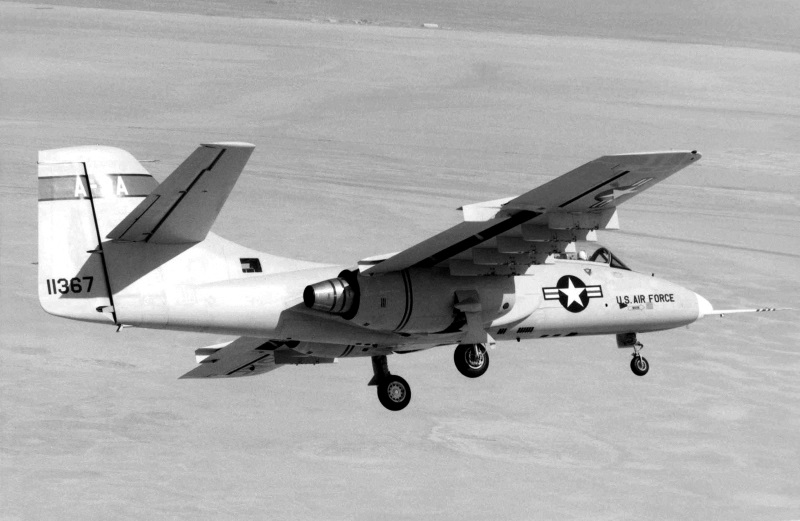
The first Fairchild YA-10A performed its initial flight on 10 May 1972, 20 days before the first YA-9A, with Howard "Sam" Nelson at the controls. The second prototype performed its initial flight on 21 July 1972. The YA-10A was unusual, maybe even a bit bizarre, in appearance. It had a low-mounted straight wing; twin GE TF34 turbofans mounted in pods above the rear fuselage; a twin-fin tail; and tricycle landing gear, with the main gear semi-retracting into fairings in the wing, a scheme that seemed to have been retrieved out of time from the 1930s. There is an old saying in aircraft design that "if it looks right it flies right", and the YA-10A seemed to have one strike against it from the outset.
Both manufacturers worked out bugs in the prototypes until they were handed over to the USAF "Joint Test Force (JTF)" on 24 October. The JTF consisted of teams from a range of Air Force commands to judge different aspects of the aircraft. The evaluation involved both practical tests and "paper" studies of the aircraft, and it was very thorough. Both the YA-9A and the YA-10A got high grades, and in fact, overall they exceeded required specifications. There was political pressure to select the YA-10A since the New York aviation industry was ailing at the time, with the AX contract being seen as a possible "make or break" deal for Fairchild, and by implication its Long Island Republic division.
Fairchild had shot itself in the foot badly a few years earlier. In the mid-1960s the Army had conducted a competition for a battlefield observation helicopter; Hiller's offering had stood a good chance of winning, but Howard Hughes sidelined Hiller through a set of behind-the-scenes intrigues involving irregular and arguably corrupt practices, with the Hughes 500 winning the deal. The end result proved to be such a mess that the Army was forced to start over and run the competition again, but Fairchild wanted nothing to do with it. The company had clearly been treated badly, but lost bigtime when Bell won the competition, almost by default, with their Model 206 / Kiowa light helicopter. The AX seemed like it might be Fairchild's last chance.
However, selecting a winner for the competition strictly on the basis of political pressure was crooked as well, and also not in the military's best interests over the long term. They needed the best weapon available for the troops in the field. Selecting the "best" in this case was troublesome, since the YA-9A was more maneuverable, while the YA-10A was easier to maintain and judged more survivable.
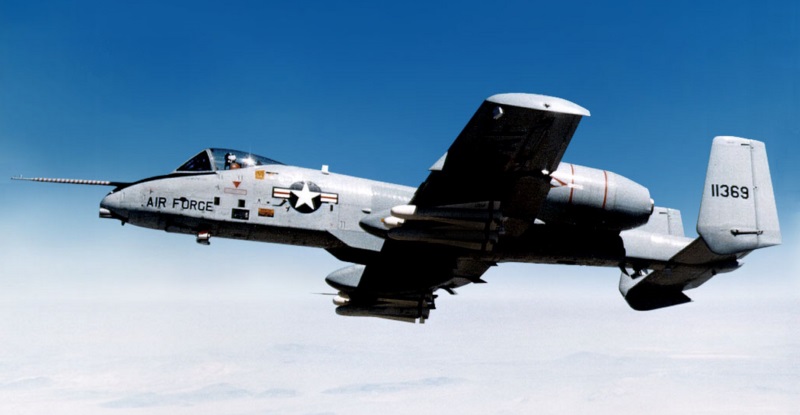
The deciding factor turned out to be Fairchild's wisdom in building a prototype closer to production specification: their machine could be put into production and service well ahead of the Northrop contender. The evaluation also showed that the YA-10A's wing was much easier to rearm than the YA-9A's high-mounted wing, which was a significant factor in mission turnaround time. The YA-10A was selected as the winner of the competition on 18 January 1973. This led to award of a $159 million USD contract for the production of ten "A-10A" pre-production "development, test, and evaluation (DT&E)" machines. Since there would be only one production variant of the A-10 -- though other variants would be flown -- the A-10A is simply referred to as the A-10 in this document.
An option was included for an initial batch of 48 production machines, but as per the instructions of Congress, the go-ahead for production would have to wait until full evaluation of the type was completed. The GE TF34 turbofan was selected for the A-10. The competitive evaluation had considered the merits of a YA-9A with GE engines and a YA-10A with Avco Lycoming engines. The Avco Lycoming ALF 502 was substantially less powerful than the TF34, but it was much lighter and the company was developing an uprated version that would be competitive with the TF34. However, the TF34 was a solution in hand, having been originally developed against a US Navy requirement for a carrier-based antisubmarine warfare aircraft, which emerged as the Lockheed S-3 Viking. Only minor modifications were required to fit it to the A-10; the Air Force was in a hurry and didn't want to take risks, so the service chose the TF34.
* In the meantime, the "shootout" between the GE and Philco-Ford candidates for the GAU-8 cannon was underway, with ground firings beginning on 15 January 1973, three days before Fairchild won the AX competition. GE had been working on heavy cannon since 1968, and coupled with their massive experience with the Vulcan they had a substantial edge over Philco-Ford. GE won the cannon competition in June 1973, receiving a $23.7 million USD contract for 11 "GAU-8/A" pre-production cannon, including three for ground testing and eight for installation into pre-production YA-10As.
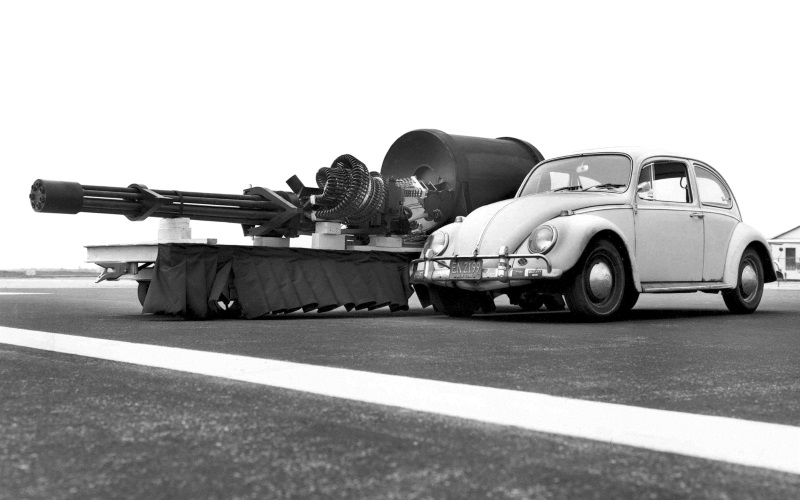
As per the instructions of Congress, the two YA-10As continued to perform trials through the rest of 1973 and into 1974, if at a less stressful pace than had taken place during the original competitive fly-off. Congress was still waffling on acquisition of the A-10, and the pre-production build was cut to six aircraft in mid-1973. Although some legislators wanted to axe the A-10 and concentrate on acquisition of the A-7D, the Air Force pushed back; in September 1973, Congress gave provisional approval for the continuation of the A-10 program -- as long as a second fly-off competition was conducted between a YA-10A and an A-7D.
The contest duly took place at Fort Riley, Kansas, in April and May 1974, and proved what the Air Force basically already knew: the SLUF might be much better for strikes into the enemy's rear, but the YA-10A was much better for getting down in the dirt with the grunts. In one particularly devastating test, the YA-10A flew to a remote field location and loitered on station for two hours; the A-7D was only able to hang around for seven minutes. In July 1974, the green light was given for construction of 52 more A-10s, including the four pre-production aircraft that had been dropped the year before and the 48 options specified in the original contract.
* The first pre-production aircraft was rolled out in late 1974, put through preliminary ground tests, then broken down and flown from Long Island to Edwards Air Force Base (AFB) on a Lockheed C-5A cargolifter. It was reassembled to perform its first flight on 15 February 1975. It was followed by the first flight of the second pre-production machine on 26 April, and the third on 10 June.
The second and third pre-production machines were the first to be fitted with the GAU-8/A cannon. The pre-production machines proved slightly overweight, but trial attacks with the cannon on old US M-48 tanks and Soviet T-62 tanks, obtained from Israel, were to put it simply, awesome, the GAU-8/A cannon all but tearing the targets to shreds. The Air Force was not inclined to worry about the fact that the A-10 was slightly overweight.
After completion of the ten pre-production machines, manufacture of full-production machines was shifted to a Fairchild plant in Hagerstown, Maryland. The first production A-10 performed its initial flight in October 1975 and was handed over to the USAF on 5 November. While early production aircraft were still used for test, trials, and evaluation, aircraft were being delivered to line units by March 1976.
* Although the A-10 was given the name "Thunderbolt II" in honor of its Republic ancestor of World War II, the name was unimaginative and never stuck with the flight crews, the military-aerospace media, or the public. It had acquired a much less dignified but more appropriate name even before the flight of the first pre-production machine.
All Republic fighters before the A-10 had been "earth lovers", reluctant to get off the runway, and so, as the story goes, the original straight-winged F-84 Thunderjet had acquired the nickname "Groundhog" or just "Hog". When the much improved swept-wing F-84F was introduced, it became known as the "Super-Hog", and the F-105 Thunderchief was sometimes called the "Ultra-Hog", though it was more generally referred to by the nickname of "Thud". In the summer of 1973, USAF Major Michael Major -- it seems no relation to the "Major Major" character in the novel CATCH-22 -- proposed in an article in an Air Force publication that the A-10 be referred to as the "Warthog". It fit so perfectly, capturing the aircraft's appearance and personality, that it caught on quickly and permanently without any real competition. In practice, it would usually be shortened to "Hog" or "Hawg".
BACK_TO_TOP* With a name like "Warthog", nobody would ever think that the A-10 could be described as "pretty" aircraft. As it emerged, it wasn't; it looked strictly for business. As mentioned, it had a low, straight wing, a twin-fin tail, tricycle landing gear, and twin TF34 turbofans perched above the rear fuselage. It had a boxy fuselage with the pilot perched high in a bubble canopy, and was built mostly of conventional aviation aluminum alloys, with the notable exception of some major titanium-armor assemblies. Fuselage elements were made up of flat panels or simple cylindrical or conical pieces to simplify manufacturing and maintenance. The muzzle of the GAU-8/A cannon stuck slightly out the nose, and the wing bristled with stores pylons for a wide range of external stores.
___________________________________________________________________
FAIRCHILD A-10 WARTHOG:
___________________________________________________________________
wingspan:
17.53 meters (57 feet 6 inches)
wing area:
47.01 sq_meters (506 sq_feet)
length:
16.26 meters (53 feet 4 inches)
height:
4.47 meters (14 feet 8 inches)
empty weight:
11,302 kilograms (24,918 pounds)
maximum take-off weight:
22,680 kilograms (50,000 pounds)
max speed at altitude:
680 KPH (425 MPH / 370 KT)
service ceiling:
13,700 meters (45,000 feet)
take-off distance:
435 meters (1,420 feet)
landing distance:
455 meters (1,500 feet)
operational radius:
465 kilometers (290 miles / 250 NMI)
ferry range:
4,150 kilometers (2,580 MI / 2,240 NMI)
___________________________________________________________________
The wing had three spars, making it very robust, and had a large area to give low wing loading, resulting in good low-speed handling and maneuverability, as well as heavy load capability with a relatively short take-off run. Unlike its Republic predecessors, the A-10 was by no means an earth-lover, though of course the amount of runway needed increased with warload. With a typical operational combat load, the A-10 could take off in about 1.1 kilometers (3,600 feet) and land in 350 meters (1,150 feet), less than half that needed for a fighter jet.
Its short-field performance was enhanced by four large "Fowler"-type flaps that extend well behind the wings. There was one flap on the inner section of each wing, one flap in the middle section, and an aileron for roll control on the outer section. The ailerons were "split", with top and bottom halves that could move independently, to act as airbrakes. This scheme provided effective braking without causing the aircraft to pitch up or down, a common difficulty with fuselage-mounted airbrakes. The outer panels of the wings had a dihedral of 7 degrees, while the wingtips were slightly turned down to improve aileron response and reduce wingtip vortexes that would impair flight efficiency. Along with short take-off capability, the A-10 was agile, valuable for both defense and offense in the battlefield environment.
There was a fuel tank in the inner section of each wing, but Fairchild engineers were reluctant to put fuel tanks in the outer sections since they would make too good a target for ground fire. The bulk of the fuel tanks were in the center fuselage between the wings, which provided them with some protection, and also made fuel trim a minor issue. Total internal fuel capacity was 7,598 liters (1,650 US gallons), ensuring that the A-10 didn't need to carry external tanks on a combat sortie. Fuel lines were routed through the tanks to shield them from ground fire. In operational practice, a Warthog pilot would use up the fuel in the wing tanks first.
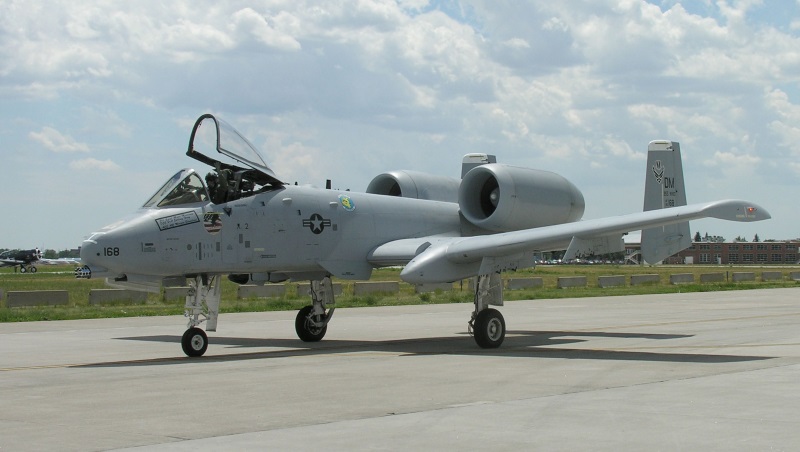
The aircraft was topped off on the ground through a single-point refueling connection in the hinged nose of the left wing landing gear fairing, which also contained a self-test control panel. There was a boom refueling socket in the nose, not featured in the YA-10As.
Incidentally, the A-10 was designed for short-field operation more than for rough-field operation. Its tricycle landing gear, all of which retracted forward, featured single wheels with low-pressure tires mounted on simple struts without shock-absorbing mechanisms. More serious "farm tractor" type landing gear would have increased cost and weight. The A-10 was intended to operate from relatively short strips of highway, runways that had been damaged by runway-dibber bombs, or leveled dirt or grass strips -- but not generally from an unprepared flat patch of ground.
The use of the old-fashioned podded fairings for the main landing gear helped reduce the complexity of the landing gear mechanism, which otherwise would have had to rotate 90 degrees to lie flat in the wing. It also eliminated the need to "cut out" the wing spars to accommodate the landing gear, which would have weakened the wing. Since the wheels didn't retract completely, that also provided some degree of protection to the airframe during a wheels-up landing. The additional drag of the fairings was judged irrelevant, given the Warthog's low flight speeds.
The tailplane also had three spars, and was very strong. The twin fins on the tail not only provider redundancy, allowing the aircraft to be controlled even if a fin was shot away, it also provided continuous control response during violent maneuvers -- since even if one rudder was blanked out by "dead air", the other was almost always still functional. Incidentally, the leading edge of the tailfins of production aircraft had a curved figure, while the leading edge on the YA-10s was angled.
* As mentioned, the GE TF34 turbofan was developed for the US Navy S-3 Viking sub-hunting aircraft. The initial "TF34-GE-2" engine went into production for the S-3A in 1972. This variant provided all the performance required for the A-10, but it was too expensive, and so GE worked to develop a simpler, cheaper version for the Warthog, designated the "TF34-GE-100". It eliminated some of the features required for maritime operation and used some cheaper assemblies, at the expense of a slight loss of thrust and slight increase in fuel consumption.
Each TF34-GE-100 provided about 40.5 kN (4,130 kgp / 9,100 lbf) thrust, and had a thrust-to-weight ratio of over 6, along with excellent fuel economy, increasing the Warthog's "time on station". The engine was also very quiet by combat jet standards, a definite advantage for the low-level front-line CAS mission, since an adversary may not hear it coming. In addition, the TF34 was designed to be easy to maintain and to be reliable, though the reliability still left something to be desired -- leading to the introduction of an improved "TF34-GE-100A" variant in the early 1980s. The TF34 was tolerant of foreign object ingestion.
The positioning of the engine pods above the rear fuselage helped improve the survivability of the machine, with the wing providing protection against ground fire, and the twin fin tail masking the exhaust from heat-seeking surface-to-air missiles (SAM) -- the fact that high-bypass turbofans like the TF34 have a relatively cool exhaust flow helped as well. The high position also protected the engines from foreign object ingestion while operating off of dirt strips. In addition, the engine placement reduced the impact of gun-gas ingestion, in which gases released by firing the cannon could choke off airflow to the engines. Considering the armament of the A-10, gun gas ingestion was a major potential problem.
The engine position did have its liabilities. At high angles of attack, the wing could block airflow to the engines -- and so a short leading-edge slat was installed between the fuselage and the main gear fairings, the slat opening automatically under hydraulic control at high angles of attack. The YA-10As uncovered that problem, and were fitted with fixed slot surfaces as an interim fix. Apparently the use of the leading-edge slats introduced another drawback in turn, in that it reduced indications to the pilot that the aircraft was going into a stall. A small strip was attached to the leading edge of each wing to ensure that the descent into a stall wasn't so abrupt.
The engine exhausts were canted up nine degrees from the centerline of the aircraft. That arrangement provided some protection against heat-seeking SAMs, but it was apparently done to reduce changes in aircraft pitch with changes in thrust. The engine pods featured large access doors -- in fact, they mostly were access doors -- to permit easy maintenance in field conditions, and reduce the need to pull the engines. There was a Garrett auxiliary power unit (APU) turbine in the fuselage between the TF34s for engine starting and ground power.
BACK_TO_TOP* The Warthog's pilot sat in an armor-plate "bathtub" that provided impressive protection against ground fire. The bathtub consisted of titanium plates, ranging from 1.27 to 3.81 centimeters (0.5 to 1.5 inches) thick, bolted together, with the assembly having a total weight of 544 kilograms (1,200 pounds), almost half the total weight of armor on the aircraft. The tub's interior was lined with "ballistic" nylon armor to block the "spalling" of titanium fragments due to hits on the exterior.
The pilot got into the A-10 using a pull-down telescoping stepladder built into the left side of the fuselage, which was not included in the YA-10As. He (or she -- eventually some femmes became Hog drivers) sat high under a bubble clamshell canopy that hinged open from the rear. The A-10 was originally fitted with the McDonnell Douglas IE-9 Escapac ejection seat, an early "zero-zero (zero height, zero speed)" ejection seat that was the standard at the time. That was later upgraded to the more d and comfortable McDonnell "Advanced Concept Ejection Seat II (ACES II)."
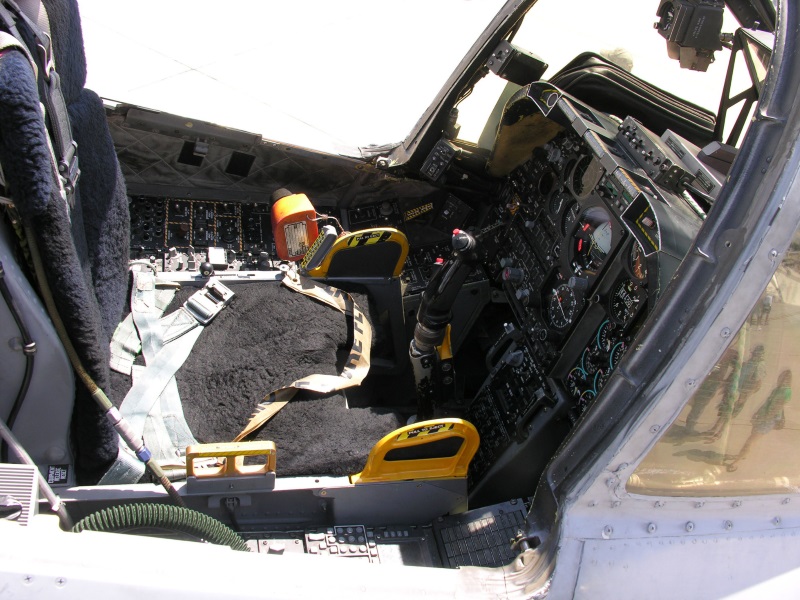
The dashboard was simple by combat jet standards, consisting of analog dials and other indicators, with the exception of a TV display in the upper right corner for guiding Maverick missiles -- more on that later -- and a Kaiser "head up display (HUD)" capable of displaying simple flight and targeting symbology. These two displays were about the only thing in the cockpit that might have been particularly unfamiliar to, say, a Republic F-84 pilot brought forward in time. Aircraft avionics were equally simple early on, though they would eventually become more sophisticated.
There wasn't even an autopilot, which would prove to be a substantial inconvenience for Hog pilots who had to relieve themselves in flight. Ordinary radios and a TACAN beacon-navigation system were initially fitted, but TACAN is a line-of-sight system, and unsurprisingly turned out to be an ineffective way for a pilot to find his way around in low-level flight. Hog pilots ended up trying to fly while figuring out where the hell they were with a map in the lap. As a result, the Air Force bit the bullet and had a standard AN/ASN-141 inertial navigation system (INS) built into the last 283 A-10s produced. The INS data was displayed on the Kaiser HUD. Since that required an update of the HUD electronics anyway, the opportunity was used to completely revise the system to provide much more sophisticated and capable symbology.
In addition, the simple classic air-pressure altimeter initially fitted to the Hog proved of limited value while jinking around the hills of Germany in crummy weather, and so late-production A-10s replaced the original altimeter with a standard AN/APN-164 radar altimeter. The INS and radar altimeter were eventually retrofitted to older Hogs in the field.
Even the INS and radar altimeter were nothing particularly special. The only halfway whizzy item fitted to the Hog was a Martin Marietta "AN/AAS-35 Pave Penny" pod on the underside of the right side of the nose on a pylon. The Pave Penny was a "laser spot tracker", which picked up the spot on which a laser target designator was focused and relayed its position on the pilot's HUD. The Pave Penny pod was not a laser target designator, and in fact it didn't even have laser rangefinder capability. Although laser spot trackers are generally fitted into the end of an aircraft's nose, the blast effect of the GAU-8/A cannon made that impossible. Incidentally, the Pave Penny pod was not fitted to initial A-10 production; it was introduced in 1978, and retrofitted to aircraft in the field.
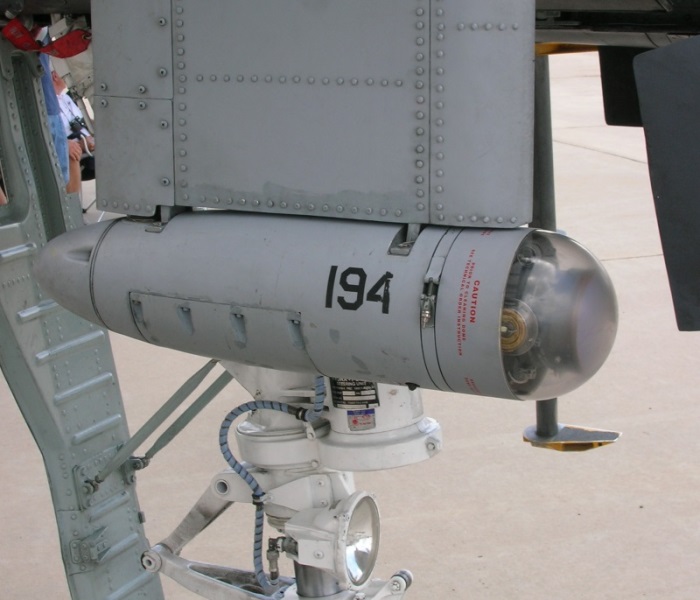
That was it as far as the Hog's internal sensors went. At the outset, the A-10's only built-in active countermeasures device was an Itek AN/ALR-46 radar warning receiver (RWR), with antenna bumps in the nose and tail, plus a little "plan position indicator (PPI)" radarscope-like display on the upper left corner of the dashboard to show the direction and location of radar-emitting threats such as tracked air-defense vehicles. The AN/ALR-46 was later upgraded to the more capable AN/ALR-64 and then AN/ALR-69 models, capable of dealing with a wider range of emitters.
The Hog was also fitted with passive countermeasures, in the form of four AN/ALE-40 chaff-flare dispensers, one under each turned-down wingtip and one in the end of each main landing gear fairing. Each AN/ALE-40 could carry 480 flares or chaff cartridges, organized in 16 batteries of 30 each. The dispensers were manually activated by the pilot.
BACK_TO_TOP* The fuselage of the A-10 was basically wrapped around the GAU-8/A Avenger cannon, which was intended at the outset to be the A-10's primary weapon. A detailed study conducted in the planning stages of the AX project showed that a heavy cannon was the most cost-effective means of killing armor. It was also the best weapon for frontline fights when friendly and hostile forces were mixed together, since picking out one from the other meant getting up close anyway, where the standoff range of an ASM was negated.
The GAU-8/A was a Gatling-type mechanically-driven machine gun, with seven barrels rotated by two hydraulic motors to fire sequentially. Its basic principles and even many of its details would have been perfectly familiar to Dr. Richard Gatling, who invented the scheme in the 1860s. Gatling actually tinkered with electrical motor drive for his guns in the 1890s and his experiments were resurrected by GE engineers after World War II, using a Gatling-built gun from a museum to perform a proof-of-concept that led to the M61 Vulcan.
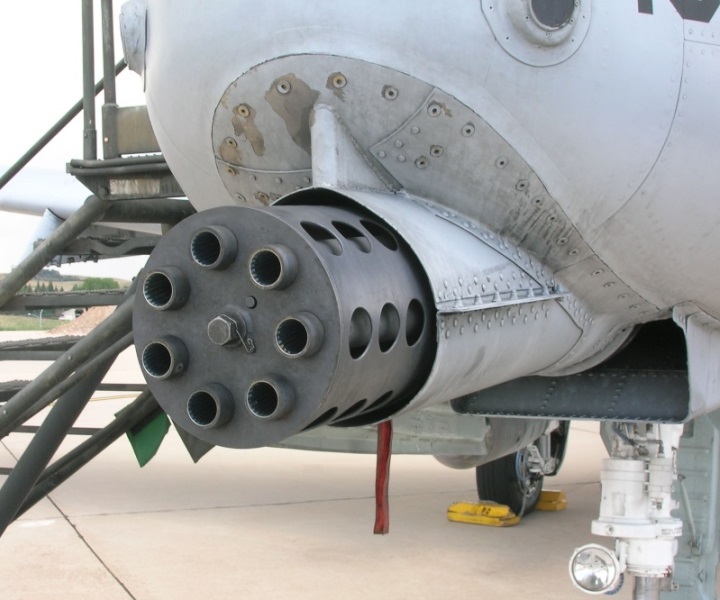
The GAU-8/A was 5.06 meters (19 feet 10 inches) long and weighed, fully loaded, 1,830 kilograms (4,029 pounds). Incidentally, strictly speaking the designation "GAU-8/A" only meant the cannon itself, with the cannon and ammo drum and so on making up the "A/A 49E-6 Gun System" -- but for the sake of simplicity, that distinction is ignored here.
The cannon could fire at selectable rates of 2,100 or 4,200 rounds a minute (35 to 70 rounds a second), and could continue to fire at the 2,100 rate if one of the hydraulic motors failed. It was highly reliable, in part as a legacy of Gatling's thorough development of his classic design. The cannon could fire armor-piercing / incendiary (API), high explosive / incendiary (HEI), and training rounds.
The API round featured a steel-cased shell with a penetrating rod made of highly dense "depleted uranium (DU)", with the rod smashing through the shell on impact and then hopefully through the armor beneath. It destroyed by kinetic energy, but also had incendiary effect as implied by the designation, since uranium will burn and the core would ignite on impact. The HEI round was more conventional, with a shell containing a high-explosive / incendiary filling, while the training round was a simple steel slug with an aluminum cap.
All the types of ammunition had aluminum-alloy cases, providing a significant savings in weight compared to steel or brass and increasing the aircraft's ammunition capacity. The shells had plastic "driving bands" to mate them to the cannon rifling, which reduced barrel wear. Different mixes of ammunition could be loaded, but the most common mix would apparently be five API for one HEI.
The GAU-8/A could fire 40 rounds in a second, placing them in a tight circle, with five or six being enough to take out heavy armor. The shells traveled at Mach 3 and, at least originally, no need to lead or shoot high to hit a target -- muzzle velocity was so high that got there almost immediately on basically a straight line. The accuracy was such that a Hog firing on a target from a range of 1.8 kilometers (4,000 feet) could place 80% of the rounds in a circle about 12 meters (40 feet) in diameter around the target. Although the Hog wasn't given a "fly by wire" flight control system (FCS), it was designed with a "Stability Augmentation System (SAS)" to add an extra degree of steadiness as a gun firing platform.
One of the major problems in development was that unburned propellant from the cannon cartridges would accumulate in front of the muzzle, and then explode in a distinctly unnerving and potentially dangerous fireball. The problem was solved by adding potassium nitrate to the propellant to encourage more complete combustion. The US Navy knew this trick from the use of heavy naval guns.
The GAU-8/A generated considerable muzzle blast, which is why the muzzle was positioned at the most forward part of the aircraft -- anything that was alongside that blast might take a beating. The cannon generated 40 kN (4,080 kg / 9,000 lb) of recoil when fired, with the firing muzzle of the cannon on the exact centerline of the aircraft to ensure that the recoil didn't throw off firing accuracy.
To ensure that firing the cannon didn't cause the Warthog to pitch up, the cannon was mounted below the aircraft's center of gravity, and was boresighted along a line 2 degrees below the aircraft's line of flight. One of the effects of this was another one of the many idiosyncrasies of the A-10: the nose gear was mounted on the right side of the nose, not on the centerline, since the cannon barrel was in the way. The oversized ammunition drum was set well back into the fuselage, just forward of the wings, to reduce the effect of changes in trim as the heavy ammunition load was expended. The position of the drum also helped protect it from hostile fire that could set off the ammunition, destroying the aircraft in a blaze of fireworks.
Tales have circulated that compared the recoil of the GAU-8/A to hitting a "brick wall", but USAF Colonel John Lieberherr, who evaluated the A-10, commented that was a great exaggeration:
BEGIN QUOTE:
The GAU-8 is a mechanical marvel, and shooting it is about the most fun one can have and keep your clothes on. It just blows things up. You don't really feel it in the cockpit, other than a low rumble / BRRRRT -- but you do smell the cordite. We had old vehicles on the gunnery range for targets, and the training rounds would penetrate the engine blocks, setting the residual oil and the targets on fire. When we did the tests against Russian tanks, they were loaded with half fuel, half ammo, and manikins. Using DU rounds alternating with HEI, we set most of them on fire.
END QUOTE
* While the GAU-8/A was intended to be the A-10's primary weapon, as mentioned the aircraft's design specifications specified that it be able to carry a hefty external warload. It had a total of eleven stores pylons -- four on each wing and three in parallel on the belly. The two outer pylons on each wing had a maximum load capacity of only 450 kilograms (1,000 pounds) each, while the two inner pylons on each wing had a maximum load capacity of 1,135 kilograms (2,500 pounds) each. The centerline belly pylon had a maximum load capacity of 2,270 kilograms (5,000 pounds) while the two off-center belly pylons had a maximum load capacity of 1,590 kilograms (3,500 pounds) each.
It was impossible to put a load on all three belly pylons at the same time -- a load could be carried on the centerline pylon, or loads could be carried on the two off-center belly pylons, but it was strictly one or the other. A vertical strake was fitted under the belly just forward of each wing root to ensure smooth airflow around the belly pylons for clean stores separation.
The outermost pylon on each wing was intended for defensive warloads, with a dual launch rack for AIM-9 Sidewinder AAMs on one wing, and an AN/ALQ-119 or AN/ALQ-131 radar jamming pod on the other. Up to three 2,536-liter (600 US gallon) external fuel tanks could be carried, with the centerline pylon and the most inboard pylon on each wing being "wet". External tanks were mostly used for ferry flights; the A-10's endurance was good, and there was usually no need for external tanks in operations.
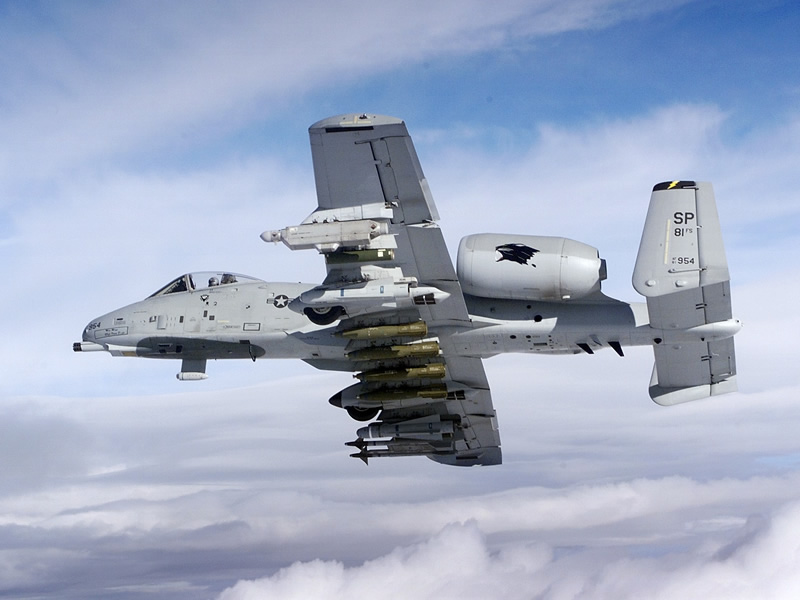
* The A-10 was designed for the battlefield CAS role, and in combat carried offensive stores appropriate to the task. General purpose HE bombs, usually with retarder tails, cluster bombs, and unguided rocket pods were useful proper warloads for front-line battlefield support missions. In principle, smaller laser-guided bombs (LGBs) were also useful in that role; although the Warthog wasn't designed with a laser target designator, ground forces had such things and could use them to precisely spot targets for strikes, with a low chance of dumping the bomb on friendlies.
However, the Hog's most characteristic external store ended up being AGM-65 Maverick ASM, and in fact as discussed earlier, the cockpit had a TV display specifically included to support the missile. The Maverick provided a degree of "stand-off" capability to allow the Warthog to pick off dangerous targets before moving in to closer range to fight with the cannon. The Mavericks were usually a mix of AGM-65B weapons, with a magnifying TV seeker, and the AGM-65D with an imaging infrared (IIR) seeker. The AGM-65D was several times more expensive than the AGM-65B, but for a long time it provided the Hog with an improvised night-combat capability, the pilot using the IIR seeker as a night vision device.
Although some press photos displayed A-10s loaded up with an impressive array of bombs and other stores, the Hog was traditionally not loaded up with anywhere near its maximum external load, since that would have basically ruined the maneuverability that was the aircraft's main means of defense. A heavy warload for a Hog might include four Mavericks, two cluster bombs, plus two Sidewinders and a jammer pod.
BACK_TO_TOP* The Warthog was designed from the ground up with survivability in mind. The US military had got a rough course in the subject over Vietnam, and as the F-105 Thunderchief carried the brunt of the USAF's strikes against North Vietnam early in the war, Republic Aviation had learned a lot from that course as well.
The F-105 was a tough aircraft and sometimes came back home with good-sized chunks ripped out of it -- but in other cases minimal damage, even possibly a single hit from a rifle-caliber bullet, could bring it down. The lesson ultimately learned was that the notion of survivability had never really been comprehensively addressed in the design stage. To be sure, Republic had always built their aircraft strong, rugged, and heavy, and items such as cockpit armor and self-sealing fuel tanks were often included, but that wasn't the same thing as sitting down at the outset and thinking out everything that needed to be done to make an aircraft as survivable as possible.
Once that mindset took hold, aircraft designers realized that they had been doing dumb things, such as installing redundant hydraulic, electrical, or control lines right next to each other. The redundant systems did generally provide some backup against a straightforward failure of one system, but if the lines of both systems were close together then one hit could knock both of them out. In other words, some fairly simple consideration of layout of the hydraulic, electrical, control, and other systems could do a great deal to improve the odds that an aircraft could make it back home safely after soaking up a number of hits. The A-10 had dual hydraulic, electric, pneumatic, and flight control systems (with a backup manual flight control system) designed along such lines, with the duplicate systems separated from each other and running through protected ducts.
Of course, Fairchild-Republic engineers had also considered obvious means of improving survivability. The cockpit armor bathtub, engine position, engine fire extinguishing system, and countermeasures gear have been mentioned. In addition, the fuel tanks were self-sealing; filled with folded ("reticulated") foam panels to slow down leakage of fuel and propagation of fire through a tank; and surrounded by rigid foam to soak up leakage and block the spread of fire. Aside from the cockpit tub, the lion's share of the armor on the A-10 protected the fuel system.
Some of the other features were less obvious. The flight and control surfaces of the A-10 were generous, not merely to improve maneuverability but to allow the machine to be flown after losing big chunks of itself. For example, it could lose half of a wing, half of the tail assembly, one of the engines, or the nose and still keep on flying. The airframe had structural redundancy so that such damage did not necessarily lead to the structural failure of other parts of the aircraft. Another interesting feature was that the landing gear was "normally open" -- kept retracted by continuous application of power, and coming down automatically if the hydraulic system failed.
The USAF conducted extensive survivability tests on the A-10 by firing a total of 707 23-millimeter rounds at major subassemblies mounted on test jigs, along with 108 rounds of smaller calibers, such as a burst of 7.62-millimeter ammunition against the windscreen.
BACK_TO_TOP* One of the clear weaknesses of the A-10 at the outset was that it was essentially a day weapon, and an adversary was clearly not going to be so considerate as to restrict his attacks to daylight hours only. In late 1977, Fairchild began talks with the USAF about a possible "Night / All Weather (N/AW)" variant, and in April 1978 the company began work on a demonstrator, using company and USAF funds and some material assistance from interested potential subcontractors.
The first development A-10 was converted to the NA/W configuration in 13 months, performing its first flight on 6 May 1979. It was a two-place tandem-seat aircraft, with a "Weapons System Operator (WSO)" in the back seat. Unsurprisingly, given how carefully thought-out the A-10's design had been, the design had provisions for a back seat from the outset.
The second seat was placed above the ammunition drum in a raised position that gave the WSO a good forward view; a few avionics boxes had to be relocated to a fairing at the rear of the cockpit. There were separate canopies for each crewperson, each canopy hinging open to the right side. The tailfins were increased in height to compensate for the aerodynamic interference of the two-seat cockpit.
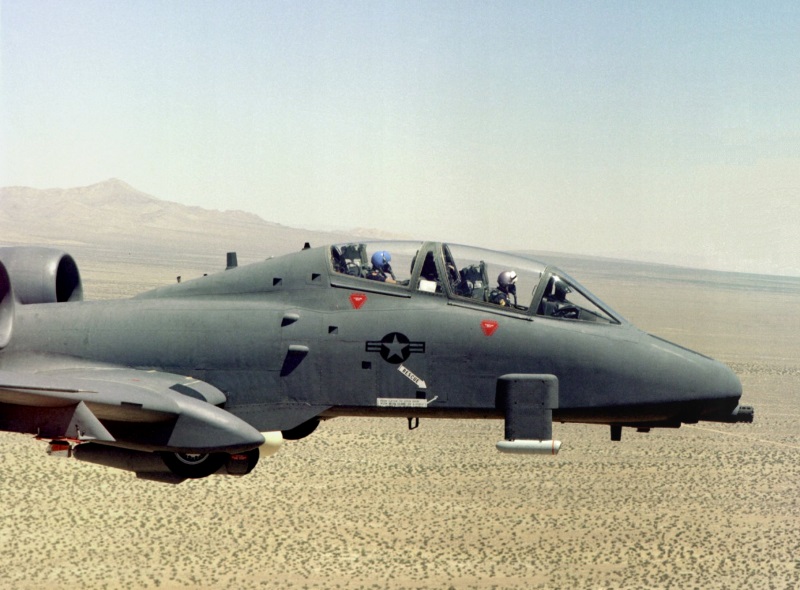
The tandem cockpit was the most visible change, but not necessarily the most significant. The NA/W Hog featured a significantly enhanced avionics suite, including:
The pilot's Kaiser HUD was modified to interface with the new avionics, and the WSO in the back seat had two CRT displays to see through the FLIR, radar, or LLLTV. The WSO had simple flight controls to allow him to take over if the pilot were disabled.
Although the N/AW Hog carried a sophisticated kit of gear, it was still much cheaper than that fitted to a fast-mover strike aircraft like the General Dynamics F-111. For example, the F-111 used its radar with an automatic terrain following system to allow it to zip over the ground at high speed, but the NA/W Hog crew didn't need automatic capability since their aircraft was so much slower. The WSO could navigate using the INS, relaying cues to the pilot, who would be watching radar, FLIR, and LLLTV inputs on his HUD.
The N/AW Hog was extensively flight-tested from 1979 into 1982, the evaluation being very successful. Fairchild promoted a production version that would have the sensors from the two pods integrated into extended main landing gear fairings; an improved one-piece clamshell canopy; and armor side panels for the rear cockpit. The company also outlined concepts for both single-seat and two-seat Hogs with various capability subsets. However, the Air Force was then working hard on the new Lockheed LANTIRN targeting pod system for their strike aircraft, and USAF officials felt that it would be a good cheap-and-dirty solution to give a standard A-10 the night / all-weather attack capability. LANTIRN was supposed to be available in 1985, and so there seemed to be no need for the N/AW Hog.
The biggest problem with the N/AW two-seater was said to be finding the qualified aircrew to fill the back seat -- training and maintaining aircrew is not cheap, and it would have been a major expense. The Hog would get the capability to fight at night and in bad weather, but it would take about another two decades, longer than even the biggest Hog enthusiasts thought the machine would remain in service. The Air Force did order 20 "A-10Bs" in 1981, which had the tandem cockpit but were strictly two-seat trainers with no advanced avionics. Congress shot the order down, for the straightforward reason that pilots said the Hog was no great challenge to fly; there seemed to be no great need for a conversion trainer, except possibly for battlefield tactical training.
BACK_TO_TOP